2012 Week 3
According to the weather forecasts, Week 3 was the last of the beautiful weather. Cool temperatures and low humidity make archaeologists happy. The coming week may be less happy. Along with the good weather, field school made major progress towards accomplishing the research goals this past week.
On the north side of the site, students discovered a previously unknown fence line.
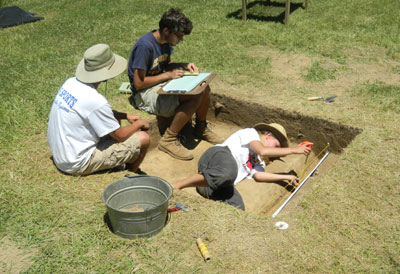
Students Chris Pasch and Carly Harmon, under supervision of field assistant Mark Jaskolski, record a newly found fence.
Most of the fences on this site are oriented parallel to the foundation of the house and are at a significant angle to the grid. The only exceptions are the very late fences, dating to the 1680s, which are parallel to the site grid. The newly discovered fence is in the latter category as it is perfectly aligned with the site grid. Such fences, found closer to the house, have large amounts of material in them. This fence, on the very northern edge of the site, had only a few small fragments of brick. How this fence fits in with the yard layout is uncertain. there are few squares in this area and those are disturbed by a number of large borrow pits. If we have time this summer, we will place a few more units to see where the fence runs.
While there were few artifacts and other materials in the fill, we were able to define some of the molds from the palings of the fence.
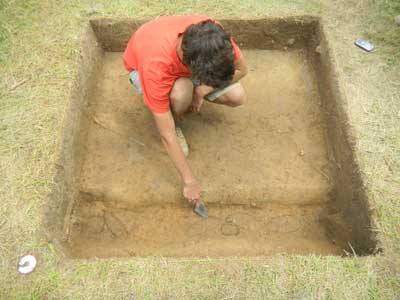
Chris Pasch point to the preserved molds of the fence pales.
As can be seen in the photo, several of the molds are thin and oblong, probably representing riven boards rather than logs as were present in many of the earlier fences. In many ways, the evidence suggests that this fence was similar to the fence presently reconstructed on the site.
In the first episode of this year’s Dispatch, I mentioned that the field school would be working in the area of the 1840s smokehouse, removing the last bricks of the floor, defining features and excavating to expose the foundation of the Calvert House.
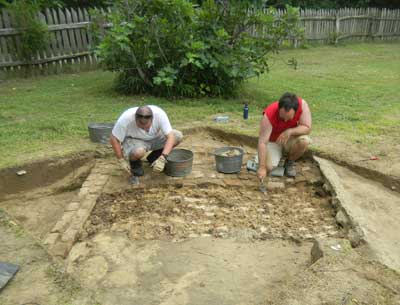
Rob Crook and John Young remove
the bricks of the 1840s smokehouse floor.
This week we began removing the brick and, as the photo shows, there was about a half an inch of sand below the bricks. The sand contained a wide range of artifacts both 17th century and 19th century.
In the sand below the bricks, we found a number of sherds of a small transfer printed plate.
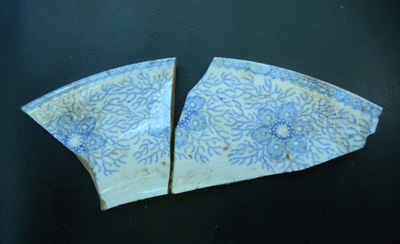
Fragments of the transfer print earthenware found under the bricks.
This pattern is identified as the “Sirius” pattern and was made by the firm of James and Thomas Edwards which was in existence from 1839-1842. This is remarkably tight dating for a building thought to be built in 1840. It is clear the Brome family, who built the 19th-century buildings on the site, had a large set of these dishes as it is the most common pattern of transfer print found here. That it was found in the sand under the earliest brick floor of the smokehouse was a very cool find.
Even more surprising was the discovery of more brick directly below the sand. However, these bricks were not related to the smokehouse but were part of the south foundation wall of the Calvert House.
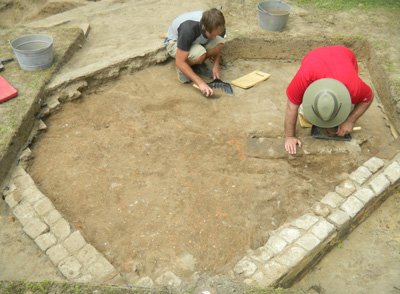
Ken Doutt and John Young clean the bricks
of the Calvert House foundation.
I had expected to have to excavate to uncover the foundation but it is clear that when the smokehouse was built in the 1840s, the foundation was still visible. This was a remarkable discovery and we were all stunned by it.
Work also began this week in the area between the smokehouse and the dairy.
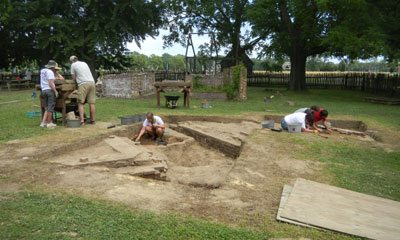
Excavations begin in the area between the smokehouse and the dairy.
It is this area where we expect to find evidence of the two cellars of the Calvert House. A level of topsoil had already been removed from this area in 1995. Below topsoil is a dark red sandy soil containing large amounts of brick rubble. It is not certain when this soil was deposited but builder’s trenches for both of the 1840s outbuildings cut through this stratum. The soil around the foundation discovered under the smokehouse bricks appears to be the same type. It is likely that this soil was an intentional fill but whether it was deposited in the 18th century or just before the outbuildings was created is unknown.
Within the dark red soil we found a large number of 17th-century artifacts including tobacco pipe and a variety of ceramics. Surprisingly, we found four large pieces of English flint in the small amount of the fill excavated this week.
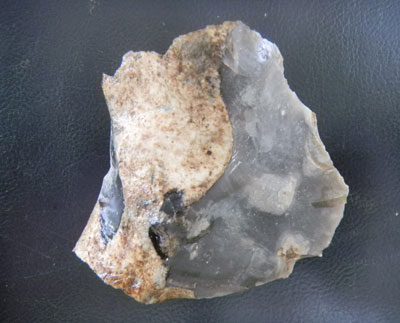
A large piece of English flint found at the Calvert House.
English flint was imported as cobbles and then worked to produce gunflints and used as fire starters. Rarely do we find such large pieces yet in this fill there were four. While this was unusual, there is not enough information about the stratum to say what it means.
One of the artifacts found in this area is both beautiful and very informative.
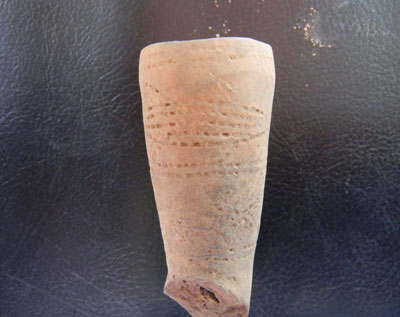
Terra cotta pipe with incised decorations of fish.
This is a complete terra cotta tobacco pipe. It is decorated with two rows of incised fish swimming in opposite directions and separated by what may be stylized water. This type of pipe was made by both Native Americans and by the colonists. What is really important is that we generally do not find these after 1670 in Maryland. That a complete pipe of this type was found in an intentional fill above the Calvert House is important. The Calvert House stood until the 18th century so the fill could not be deposited until that period. This suggests that the fill, and the artifacts in it, comes from somewhere else on the site. This is a small point but it helps us begin to understand how the site was filled in and will provide insights on the sequence of fills.


